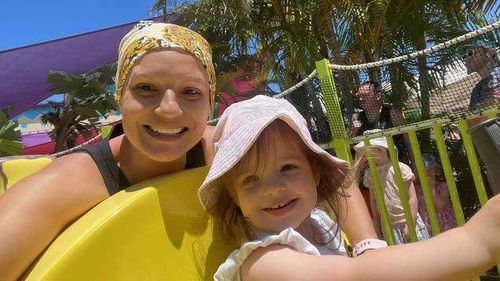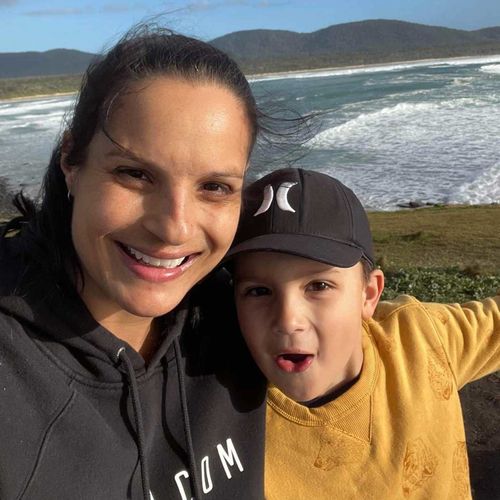The mother of a NSW woman who died of cervical cancer has told how her daughter spent more than a year trying to get doctors to listen to her concerns.
Amanda Ne’Roi is speaking out about her daughter Jaime’s devastating case as three peak research organisations – the Australian New Zealand Gynaecological Oncology Group, Ovarian Cancer Australia and the Ovarian Cancer Research Foundation – join forces to call on the government to commit $100 million in funding towards gynaecological cancer.

However, survival rates for gynaecological cancers have stagnated and fallen well behind improvements for other cancers, such as breast cancer.
In the 15 years between 1991–1995 and 2016–2020, the five-year survival rate for women with gynaecological cancers increased by just 6 per cent, compared with 13 per cent for breast cancer, the AIHW data shows.
Ne’Roi said Jaime knew something was not right a few months after she gave birth to her second child, Indiana, in May 2020.
“She was having spotting, discharge, and an upset stomach. She felt sick. She just knew something was wrong,” Ne’Roi said.
Jaime went to her GP, who referred her to a gynaecologist she had seen a decade earlier, when abnormal cells were detected on her cervix.
At the time, the gynaecologist decided against a hysterectomy because she was yet to have children.
Ne’Roi said the gynecologist dismissed her daughter’s symptoms because she had recently given birth.
“He said it was just because she had a baby. He didn’t even give her a pap smear test,” Ne’Roi said.

Jaime then went to another gynaecologist, who also attributed the symptoms to her having had a baby and put her on the contraceptive pill, Ne’Roi said.
“She kept saying to them, there’s something very wrong.”
Ne’Roi said she remembered having conversations with Jaime, who was very worried, and telling her to go back to the gynaecologist.
After another visit, the gynaecologist agreed to do an internal examination via a laparoscopy in August 2021, which revealed Jaime had stage 3 cervical cancer at the age of 37.
“By the time she actually got a doctor to listen, she had a seven-centimetre tumour and it was inoperable,” Ne’Roi said.
Jaime underwent radiation and chemotherapy, and briefly received good news in December 2021, when a scan showed up clear.
However, by February 2022 the cancer was back and had spread to her uterus and lymph nodes.
A hysterectomy and more chemotherapy and radiation followed, but Jaime’s health was deteriorating fast.
The last option presented by Jaime’s doctors was immunotherapy, however, the family was told it would need to foot the bill at a cost of $6000 a fortnight.
“My husband and I were looking at selling up our property, everything – so were her brothers,” Ne’Roi said.
With the money needed immediately, however, the family started an online fundraiser, which allowed Jaime to start the treatment.
The treatment was not unsuccessful and Jaime died in July 2023, just under two years after she was first diagnosed.
She left behind her partner and two children, Harrison, then aged six, and Indiana, aged one.
“The hardest thing I’ve had to do in my whole entire life was to tell my grandson his mum had gone,” Ne’Roi said.
“He burst into tears and said, ‘I just want my mommy back.'”

Rates of cervical cancer have been increasing in Australia, despite the national rollout of the HPV vaccine in 2007, which provides some protection against the cancer-causing virus.
Between 2000 and 2024, incidence rates of cervical cancer have climbed from 5.5 cases per 100,000 people to 8, AIHW data shows.
Ne’Roi said Jaime had been vaccinated for HPV, which showed why women should not become complacent about the disease.
“I think the trouble is, people become very complacent about gynecological cancers, they aren’t mentioned much. Breast cancer is huge,” Ne’Roi said.
“I’m sharing this story to illustrate the hidden crisis impacting all Australian women, because it can hit any one of us at any time.”
More money was desperately needed for research for all gynecological cancers, Ne’Roi said.
Professor Clare Scott, Australia New Zealand Gynaecological Oncology Group (ANZGOG) chair, said gynecological cancers had been left underfunded for decades and were a hidden crisis that was expected to grow.
Gynecological cancers – which include uterine, ovarian and cervical cancers – are predicted to surge by 21 per cent over the next 10 years.
“For too long, gynaecological cancers have been overlooked and underfunded, leaving women with limited treatment options and unacceptable survival rates,” Scott said.
“These are not just statistics – they are our mothers, sisters, daughters, wives, and friends… we must do better.”
ANZGOG, along with Ovarian Cancer Australia and the Ovarian Cancer Research Foundation, are seeking $100 million in federal government funding over four years to go towards more personalised treatments for patients, clinical education, a national research databank and drug trials.
“The survival rates for gynaecological cancers have barely changed in decades. That fact alone should be a wake-up call,” Ovarian Cancer Research Foundation CEO Robin Penty said.
“We know that the answers are there – they lie in research and in better understanding of women’s bodies and women’s pain. To reveal them we need appropriate and proportionate investment.”
A spokesperson for Health Minister Mark Butler said he would continue discussions with the ANZGOG about their proposal.
“The Albanese Labor government is doing all we can to support patients, families, loved ones and carers on the cancer journey,” the spokesperson said.
“That’s why we fund a range of programs to ensure Australians diagnosed with gynaecological cancer have better outcomes no matter where they live.”







